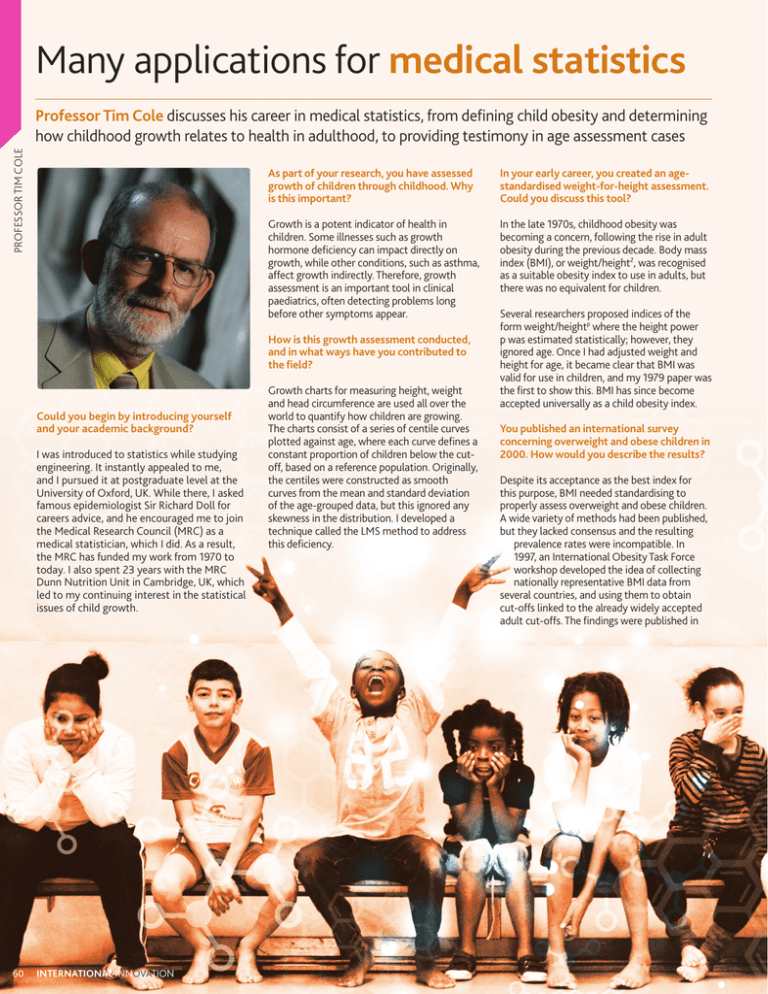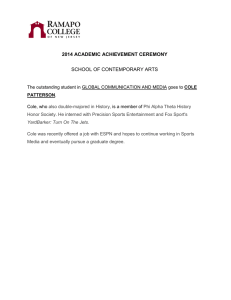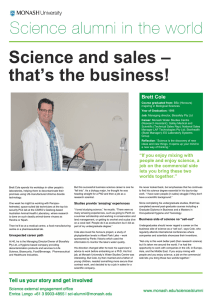Many applications for medical statistics
advertisement

Many applications for medical statistics PROFESSOR TIM COLE Professor Tim Cole discusses his career in medical statistics, from defining child obesity and determining how childhood growth relates to health in adulthood, to providing testimony in age assessment cases As part of your research, you have assessed growth of children through childhood. Why is this important? In your early career, you created an agestandardised weight-for-height assessment. Could you discuss this tool? Growth is a potent indicator of health in children. Some illnesses such as growth hormone deficiency can impact directly on growth, while other conditions, such as asthma, affect growth indirectly. Therefore, growth assessment is an important tool in clinical paediatrics, often detecting problems long before other symptoms appear. In the late 1970s, childhood obesity was becoming a concern, following the rise in adult obesity during the previous decade. Body mass index (BMI), or weight/height2, was recognised as a suitable obesity index to use in adults, but there was no equivalent for children. How is this growth assessment conducted, and in what ways have you contributed to the field? Could you begin by introducing yourself and your academic background? I was introduced to statistics while studying engineering. It instantly appealed to me, and I pursued it at postgraduate level at the University of Oxford, UK. While there, I asked famous epidemiologist Sir Richard Doll for careers advice, and he encouraged me to join the Medical Research Council (MRC) as a medical statistician, which I did. As a result, the MRC has funded my work from 1970 to today. I also spent 23 years with the MRC Dunn Nutrition Unit in Cambridge, UK, which led to my continuing interest in the statistical issues of child growth. 60 INTERNATIONAL INNOVATION Growth charts for measuring height, weight and head circumference are used all over the world to quantify how children are growing. The charts consist of a series of centile curves plotted against age, where each curve defines a constant proportion of children below the cutoff, based on a reference population. Originally, the centiles were constructed as smooth curves from the mean and standard deviation of the age-grouped data, but this ignored any skewness in the distribution. I developed a technique called the LMS method to address this deficiency. Several researchers proposed indices of the form weight/heightp where the height power p was estimated statistically; however, they ignored age. Once I had adjusted weight and height for age, it became clear that BMI was valid for use in children, and my 1979 paper was the first to show this. BMI has since become accepted universally as a child obesity index. You published an international survey concerning overweight and obese children in 2000. How would you describe the results? Despite its acceptance as the best index for this purpose, BMI needed standardising to properly assess overweight and obese children. A wide variety of methods had been published, but they lacked consensus and the resulting prevalence rates were incompatible. In 1997, an International Obesity Task Force workshop developed the idea of collecting nationally representative BMI data from several countries, and using them to obtain cut-offs linked to the already widely accepted adult cut-offs. The findings were published in PROFESSOR TIM COLE Age, crime and punishment the British Medical Journal in 2000 and proved widely popular – to date the paper has been cited over 5,000 times, as counted by Web of Science. What is the purpose of your current scientific endeavour to create the SuperImposition by Translation And Rotation (SITAR) method? SITAR is an extension of the LMS method that works with series of measurements for individuals, plotted as growth curves rather than individual measurements. It summarises a group of these growth curves very simply as a set of three transformations per curve and a mean curve. The three transformations correspond to the individual’s relative size and underlying developmental age – so, for example, it detects whether puberty is early or late. In 2011, you gave expert testimony in court cases across Australia concerning people smuggling. How did you become involved in these cases? A paediatrician colleague had been asked to give expert witness evidence at an age assessment hearing about a young man arrested while crewing a ship carrying asylum seekers. He was charged with people smuggling, an offence with a five-year jail sentence, unless he could show he was under the age of 18. He claimed he was under 18, but the prosecution (relying on a bone age assessment) disagreed. My colleague suggested I look at the case, and I immediately saw that the bone age assessment was flawed. I added an appendix to his witness statement, and in due course the case was dismissed. The flood gates then opened, and I was contacted by solicitors from all over Australia asking me to give evidence on behalf of their similarly-charged clients. An exciting application of Professor Tim Cole’s methods is his work to determine the age of defendants in people smuggling court cases. He has provided testimony in more than 10 cases, ensuring appropriate outcomes PEOPLE SMUGGLING IS a significant problem in Australia; in fact, in 2012, more than 17,000 people arrived in Australia by boat. Oftentimes, the individuals smuggling people across the border are Indonesian fishermen. When caught in the act, the smugglers are arrested and can be held in immigration detention by the Australian authorities for many months. Once arrested, age becomes of critical importance in these detainees: smugglers under the age of 18 are repatriated, while those over 18 face trial and, if found guilty, can be sentenced to five years imprisonment. Some smugglers claim to be under the age of 18, and if they do not have identity papers – and generally they do not – their age is assessed by other means. DETERMINING CHRONOLOGICAL AGE Bone age is an important physical marker that countries use to determine age. In legal cases where age is in question, an X-ray of the defendant’s hand and wrist is taken and compared to a reference textbook containing a series of hand-wrist X-rays, each corresponding to a different age. These defendants are then tried based on the age that their skeletal maturity matches. The logic behind this comparison lies in the way that hand and wrist bones grow. As individuals progress through their biological journey, the appearance of their bones changes; therefore, the X-ray of an 8-year-old will generally look different to that of a 12 or a 19-year-old. A FLAW IN THE SYSTEM However, according to Professor Tim Cole of University College London, UK, while using a physical development method like bone age to determine chronological age is simple, it is also inherently flawed, especially for people between the ages of 16 and 18. Developmental age and chronological age do not always correlate in these teenage years. Moreover, once a child becomes physically mature, their skeletal maturity becomes impossible to differentiate from that of an adult; in fact, this method of using bone X-rays to decide if they are under 18 returns the wrong answer more than a third of the time. In addition to bone age measurements being highly inaccurate when the marker has matured, Australian authorities have been basing age assessments in court cases and immigration scenarios on an entirely incorrect assumption: since 19-year-old boys tend to have a mature X-ray, they have been equating 19 to the mean age for adult X-rays. This inaccurate argument has been used as evidence in numerous court cases to convict young men of people smuggling, potentially leading to many wrongful convictions. STATISTICS FOR JUSTICE Cole has been working to address this legal injustice, and his work in this arena has yielded impressive results. He has shown that the system clearly penalises skeletally mature people, as X-rays do not provide enough evidence to conclude whether young men with a mature hand-wrist X-ray are over 18, or even over the age of 16. “I have provided expert witness evidence to 11 age assessment hearings. In each case, the prosecution argued that since their X-ray was mature, they were likely to be over 18,” states Cole. “I argued that what matters is the age of attainment of the mature X-ray, and I showed that, in fact, the majority of boys with a mature X-ray were actually under the age of 18 when their X-ray became mature. The courts agreed, and dismissed all but one of the cases.” When considered alongside other issues, such as radiation dose, Cole states that it is clear that the hand-wrist X-ray should no longer be used as evidence: “Immigration authorities need to acknowledge this reality, and work with professionals to come up with a more effective procedure based on information from physical, psychological and social assessments,” Cole comments. Cole is well on his way to convincing countries to stop this practice. In fact, in May 2013 the Australian Government announced it would no longer use bone age as evidence in age assessment hearings. WWW.RESEARCHMEDIA.EU 61 PROFESSOR TIM COLE Growth is an important measure of health in children, and charts are used worldwide for such assessments. Underlying these growth charts are statistical methods that have relevance for medicine, epidemiology and policy THE ASSESSMENT OF child growth is important for medical practice, public health and policy. On the simplest level, healthy children grow well, while ill children often fail to thrive, and it is important to be able to tell which group a child falls into. Measuring changes to the growth and size of children through growth charts is a simple but effective method of evaluating their health, and it is used by midwives, nurses and paediatricians worldwide, but constructing and using these charts requires complex statistics. the assessment of growth, enabling more accurate assessments of nutritional status. It also provided the first evidence that BMI must be adjusted for age before it can be used as an index of obesity in children. Based on Cole’s research, age-adjusted BMI is now the basis of all childhood obesity assessments worldwide. “The importance of accounting for age when relating different measures of body size is a recurring theme in my work,” Cole comments. Tim Cole, Professor of Medical Statistics at the University College London (UCL) Institute of Child Health, has devoted his career to studying the statistics of growth and development and has devised and improved methods for their measurement. In doing so, he is helping to answer fundamental biological questions, such as how to define healthy growth, and how to predict future health from childhood growth profiles. Although age-adjusted BMI had been universally accepted as the best index for child growth, Cole saw a flaw in its use: “BMI needed to be standardised to properly assess child overweight and obesity, with consensus on how to adjust for age and which cut-offs to use,” Cole explains. For this he was able to use the LMS method – a statistical technique he had created to construct centiles for growth charts. BODY MASS INDEX Body mass index (BMI) – measured by weight/ height2 – has been used as a screening tool to assess weight problems in adults for decades. Previous to 1979, a weight-for-height standard was used in children, based on the assumption that the expected weight for a given height did not depend on age – an assumption Cole showed to be incorrect in his seminal paper, ‘A method for assessing age-standardized weightfor-height in children seen cross-sectionally’. In the paper, he presented a new method that overcame the problem of age dependence in the weight-height relationship. He showed that until puberty, the following ratio is a simple and accurate index of weight-for-height: age-standardised weight/(age-standardised height)2. This represented a turning point in 62 INTERNATIONAL INNOVATION THE LMS METHOD Reference centile curves, which show the distribution of a measurement as it changes according to a covariate (usually age) are commonly used as a screening tool in medicine to identify patients with unusual measurements. However, the original method of constructing centile curves ignored skewness in the distribution. To address this, Cole assumed an underlying skew normal distribution of the measurements, such that a suitable power transformation would normalise the distribution. The distribution at each age can be summarised by three parameters, as he explains: “As well as curves for the mean (μ or M) and standard deviation (SD) (σ or S) it introduced a third curve λ (or L) for the degree of skewness in the distribution, hence it was called LMS”. All three parameters are constrained to change smoothly as age changes and can be plotted against age. As a result, a major advantage of the method is that the three curves entirely summarise the measurement’s distribution over the age range. The LMS method provided a convenient system to fit smooth reference centile curves, highlighted features of the underlying distribution as age changed and provided a tool to determine their relative importance. Today it is used worldwide for the construction of growth references. DEFINING CHILDHOOD OBESITY In 2000, Cole applied his LMS method to develop a standardised definition of overweight and obesity in children. The paper has received around 10,000 Google citations – indicating its almost universal acceptance. At the time no internationally accepted definition for childhood obesity was recognised, making it almost impossible to monitor trends of great importance for public health. To develop these definitions, a global survey was initiated, including six nationally representative cross-sectional growth studies. Although the ideal definition of obesity is based on the amount of fat in the body, it is not feasible for epidemiological use. As Cole had already shown BMI to be an effective measure, he explored it as an alternative. Although less sensitive, it was in widespread use for adult populations, with cut-off points of 25 and 30 kg/m2 as the recognised definitions of adult overweight and obesity, respectively. As the adult cut-off points were related to health risk and round numbers, an International Obesity Task Force workshop suggested that they be linked to BMI centiles for children. INTELLIGENCE A growth chart to assess birth weight and weight gain in very preterm infants. The grey centile curves for birth weight are constructed by the LMS method, while the coloured growth curves, which show the mean pattern of postnatal weight gain according to gestation, are estimated by the SITAR method. Reproduced with permission from Cole, TJ et al. 2014, Arch Dis Child, 99, F34-F40. ASSESSMENT OF CHILD GROWTH OBJECTIVES To develop general methods for the statistical analysis of data relating to physical growth and development. This includes assessment of cross-sectional data (LMS method), longitudinal growth curves (SITAR method), developmental age (based on imaging) and child obesity (IOTF cut-offs). The applications are experimental, clinical and epidemiological across the life course. KEY COLLABORATORS To meet this challenge, Cole examined the BMI in almost 200,000 people from birth to 25 years of age, and he developed age- and gender-specific cut-off points using datasetspecific centiles linked to adult cut-off points. These threshold values were less arbitrary and more internationally representative than those previously used. They also provided internationally comparable prevalence rates of overweight and obesity in children. IMPROVING GROWTH CHARTS In 2006, the World Health Organization (WHO) published a new growth standard for children under five years of age. It was compiled using data from carefully selected children in six different countries, representing a reliable standard against which the growth of all children could be assessed. The UK was among the first countries to adopt the standard. An expert group modified it, along with the existing UK 1990 reference (UK90), to design new charts and usage instructions, plotting aids and training materials. Cole was heavily involved in this process, as he explains: “I contributed to several new features: centiles for weight and height in puberty, a simplified way to derive BMI and two different ways to predict a child’s adult height”. The new UK-WHO growth charts, published in 2009, were considerably easier to use than their predecessors. Moreover, the accompanying materials have improved general understanding of how growth charts should be used. They are now used by all paediatric professionals and provided to new mothers in the UK. CHARACTERISING GROWTH CURVES Most recently, Cole has focused on growth curve modelling. Growth curves are a useful source of information about a child’s genetics and environmental exposures. They enable medical professionals to understand the effect of previous exposures and to predict future outcomes. An important aspect of growth is the growth spurt, when height suddenly increases during puberty. The timing and intensity of the spurt varies between individuals and can be summarised using Preece-Baines curves. Their five parameters can be related to earlier exposures and later outcomes, but it requires fitting many individual curves – a laborious process. In view of this limitation, Cole developed an alternative: the SuperImposition by Translation And Rotation (SITAR) model. This shape invariant model uses a single fitted curve to match curves for individuals to the mean through a set of three transformations. The outcome – a mean curve plus triplets of parameters per individual – summarises individual growth patterns very effectively. “Timing corresponds to SITAR tempo and the intensity to SITAR velocity, while SITAR size is simply mean height,” Cole explains. “Surprisingly, this simple formulation can explain as much as 99 per cent of variation in height.” This statistical method is based on the biology of growth, allowing developmental age in individuals to differ from chronological age. As a result, it is remarkably effective at explaining the differences in growth pattern between individuals and may even enable prediction of disease risk: “SITAR provides a way to identify at-risk individuals whose developmental age is advanced, a risk factor for later obesity,” he comments. LOOKING AHEAD Using a combination of statistics and biology, Cole has revolutionised the way we assess child growth, developing statistical methodology with important implications for clinical practice. To maximise their impact, he plans to make his statistical methods more widely available. He has developed a SITAR software library in the statistical language R, an open source programming environment that statisticians use. Dr Ann Prentice, MRC Human Nutrition Research, Cambridge, UK Professor Charlotte Wright, University of Glasgow, UK Professor Jonathan Wells, UCL Institute of Child Health, London, UK FUNDING Medical Research Council (MRC) External Scientific Staff CONTACT Professor Tim Cole Chair in Medical Statistics UCL Institute of Child Health 30 Guilford Street London, WC1N 1EH UK T +44 020 7905 2666 E tim.cole@ucl.ac.uk iris.ucl.ac.uk/iris/browse/ profile?upi=TCOLE39 TIM COLE studied engineering at Cambridge University, UK, and then trained in biostatistics at the University of Oxford, UK. In 1970, he joined the MRC Pneumoconiosis Research Unit in South Wales, where he researched factors affecting lung function in health and disease. He then spent over 20 years at the MRC Dunn Nutrition Unit in Cambridge, where he developed his interests in child growth. He transferred to the UCL Institute of Child Health in 1998, as MRC External Scientific Staff, where he holds a personal chair in medical statistics. To date he has published over 400 peer-reviewed papers with 55,000 Google citations. He also hopes to use SITAR in more diverse contexts: “SITAR has potential for summarising longitudinal data where the underlying age scale varies between individuals. This applies to measurements such as hormones, lung function and bone maturation,” he concludes. WWW.RESEARCHMEDIA.EU 63






